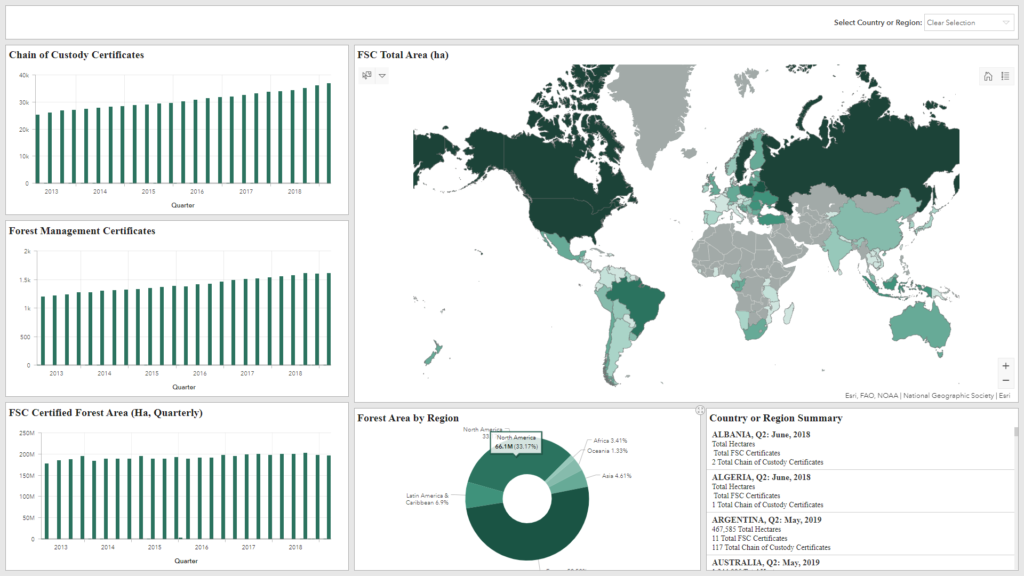Forest Stewardship Council's mission is to promote environmentally sound, socially beneficial and economically prosperous management of the world’s forests. Their vision is that we can meet our current needs for forest products without compromising the health of the world’s forests for future generations

The FSC Dashboards, created by the Forest Stewardship Council and Blue Raster, provide an interactive outlet to explore where FSC Certified Forests and Certificates are currently located. Sharing these ArcGIS Operations Dashboards gives viewers a look into the breadth of FSC's impact and explores physical boundaries of managed forests on top of satellite imagery. This can be analyzed against authoritative global forest extent and change data for verification and accountability purposes.

Before a forest owner or manager can certify their forest, they must meet the ten FSC principles for responsible forest management. These rules apply to all forest types and are in place to ensure environmentally appropriate, socially beneficial, and economically viable forest management. The FSC 10 principles are below.
The 10 rules for responsible forest management
PRINCIPLE 1:
The Organization shall comply with all applicable laws, regulations and nationally-ratified international treaties, conventions and agreements.
PRINCIPLE 2:
The Organization shall maintain or enhance the social and economic well-being of workers.
PRINCIPLE 3:
The Organization shall identify and uphold Indigenous Peoples’ legal and customary rights of ownership, use and management of land, territories and resources affected by management activities.
PRINCIPLE 4:
The Organization shall contribute to maintaining or enhancing the social and economic well-being of local communities.
PRINCIPLE 5:
The Organization shall efficiently manage the range of multiple products and services of the Management Unit to maintain or enhance long term economic viability and the range of environmental and social benefits.
PRINCIPLE 6:
The Organization shall maintain, conserve and/or restore ecosystem services and environmental values of the Management Unit, and shall avoid, repair or mitigate negative environmental impacts.
PRINCIPLE 7:
The Organization shall have a management plan consistent with its policies and objectives and proportionate to scale, intensity and risks of its management activities. The management plan shall be implemented and kept up to date based on monitoring information in order to promote adaptive management. The associated planning and procedural documentation shall be sufficient to guide staff, inform affected stakeholders and interested stakeholders and to justify management decisions.
PRINCIPLE 8:
The Organization shall demonstrate that, progress towards achieving the management objectives, the impacts of management activities and the condition of the Management Unit, are monitored and evaluated proportionate to the scale, intensity and risk of management activities, in order to implement adaptive management.
PRINCIPLE 9:
The Organization shall maintain and/or enhance the High Conservation Values in the Management Unit through applying the precautionary approach.
PRINCIPLE 10:
Management activities conducted by or for The Organization for the Management Unit shall be selected and implemented consistent with The Organization’s economic, environmental and social policies and objectives and in compliance with the Principles and Criteria collectively.
Related Posts
- Promoting Sustainable Forestry Practices with High Resolution Imagery
- GFW Pro: Managing Deforestation Risk in Commodity Supply Chains
- Jane’s Green Hope: Blue Raster supports 87 Years of Jane Goodall’s Impact
- Towards Zero Deforestation with GFW Pro
- Improving Deforestation Risk Management in Commodity Supply Chain
